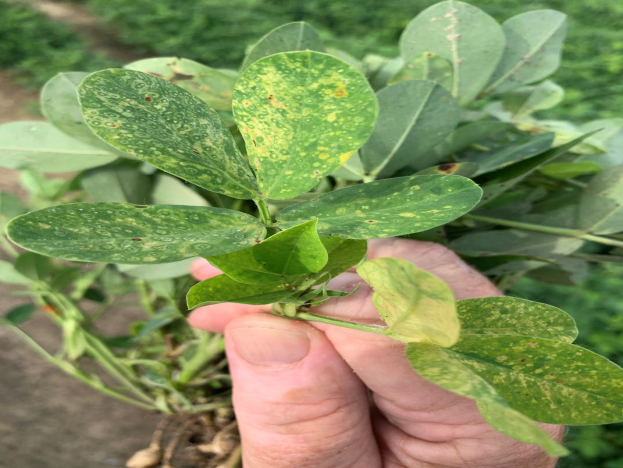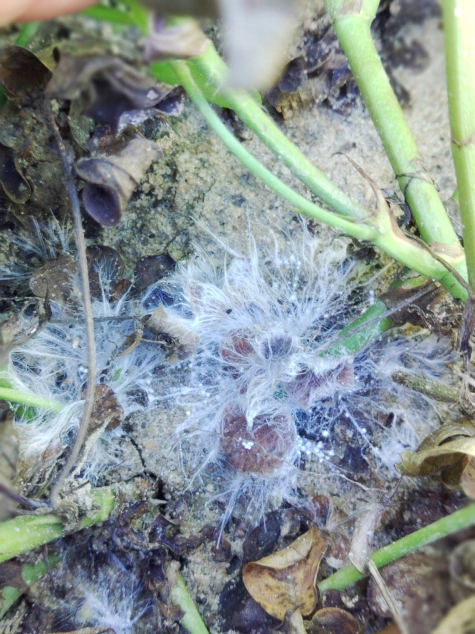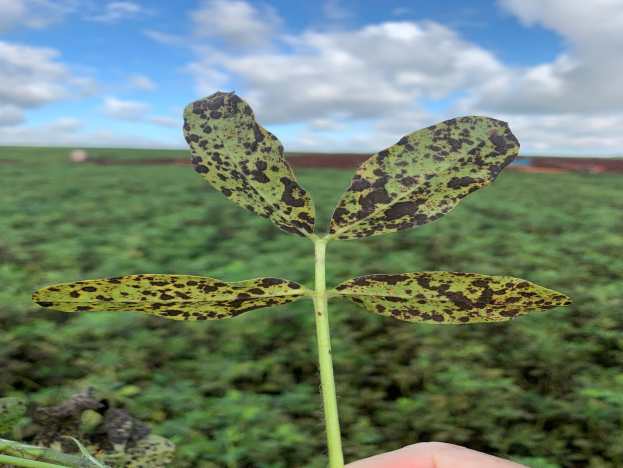August: a month to manage diseases both now and in the future
Bob Kemerait, Plant Pathologist, UGA
August is a month that is critically important for disease and nematode management for peanuts
grown in Georgia. Heat, humidity, sporadic rainfall, days since planting, and growth of the peanut plants
all put the crop at high risk for diseases, especially white mold and leaf spot. The heat, humidity,
rainfall, and irrigation are near-perfect in August of 2022 for infection and development of fungal diseases. The dense canopy of foliage that has developed in many fields traps moisture and humidity, thus prolonging leaf wetness periods and increasing risk to diseases. The dense canopy of foliage also makes it more difficult for fungicides applied to the leaves to reach the crown of the plant for protection
against white mold.
By this time of the season, much of the crop is between 90 and 100 days after planting, which is
sufficient time for leaf spot and white mold to become established in most, if not all, fields.
Incidence of disease is should be lower in well-rotated fields and/or in fields where appropriate and timely fungicide programs have been deployed. Where crop rotation is short, or where there have been delays in fungicide applications, or where the choice of fungicide could have been better, peanut growers may find that August is the month to fight to find some way to re-gain control of disease in the field.
For disease management in August, I have five recommendations.
- Growers should continue to scout their fields, or to have their fields scouted for them, to
ensure
that there are no surprises as far as the development of white mold or leaf spot. - Growers should recognize that even where there is good disease control in a field NOW, there is
plenty of season left until harvest. NOW is not the time to relax on a disease management
program. - Growers should recognize that while near-perfect control of peanut leaf spot diseases is
possible, though not necessary for top yields, it is nearly impossible to have “perfect” control of
white mold. Initial infection for white mold is likely to occur from individual plants being
infected by sclerotia in the soil close to the plant. From this initial infection, the disease can
spread and burn along a row, resulting in significant yield loss. NO fungicide program will
eliminate initial “dinner plate sized” hits of white mold in a field (though good crop rotation
will
do that). A GOOD fungicide program will stop the initial “hits” of white mold from burning down
the row. If your program is not stopping the “burn”, then we need to figure out why. It could
be the fungicide is not reaching the intended target. It could be the fungicide is applied too late
or at the wrong rate. Or, it could be that a better fungicide could be used. - There is significant interest in mixing SPECIFIC formulation of sulfur, remember that NOT ALL
sulfur products are effective for management of leaf spot in peanut. It is my experience that
sulfur in the right formulation mixed with the right product is similar to adding a pint of
chlorothalonil. Adding sulfur to a fungicide for leaf spot control is not magic, but it can be a
cost-effective way to improve leaf spot control. - Better products and systemic products. I don’t look for any white mold products to be systemic,
but some fungicides are better at fighting white mold than are others. Some leaf spot fungicides
DO have limited systemic/curative activity against leaf spot diseases and these products can and
should be used judiciously in the peanut fields.
Disease problems typically become most obvious during the month of August in Georgia’s peanut
fields;
however there are some problems that cannot be fixed now. Examples of these include damage from
the Tomato spotted wilt virus and from nematodes. Opportunity to manage Tomato spotted wilt and
peanut root knot nematodes largely ended when the furrow was closed at planting. Damage from these
maladies is often quite evident in August as stress increases on the crop. Evidence of damage is a
poignant reminder that grower should consider adjusting management strategies for the 2023 crop.
- Tomato spotted wilt from Midville
- White mold from Raymond Joyce, Lauren’s County
- Severe late leaf spot, Kampong Cham, Cambodia


